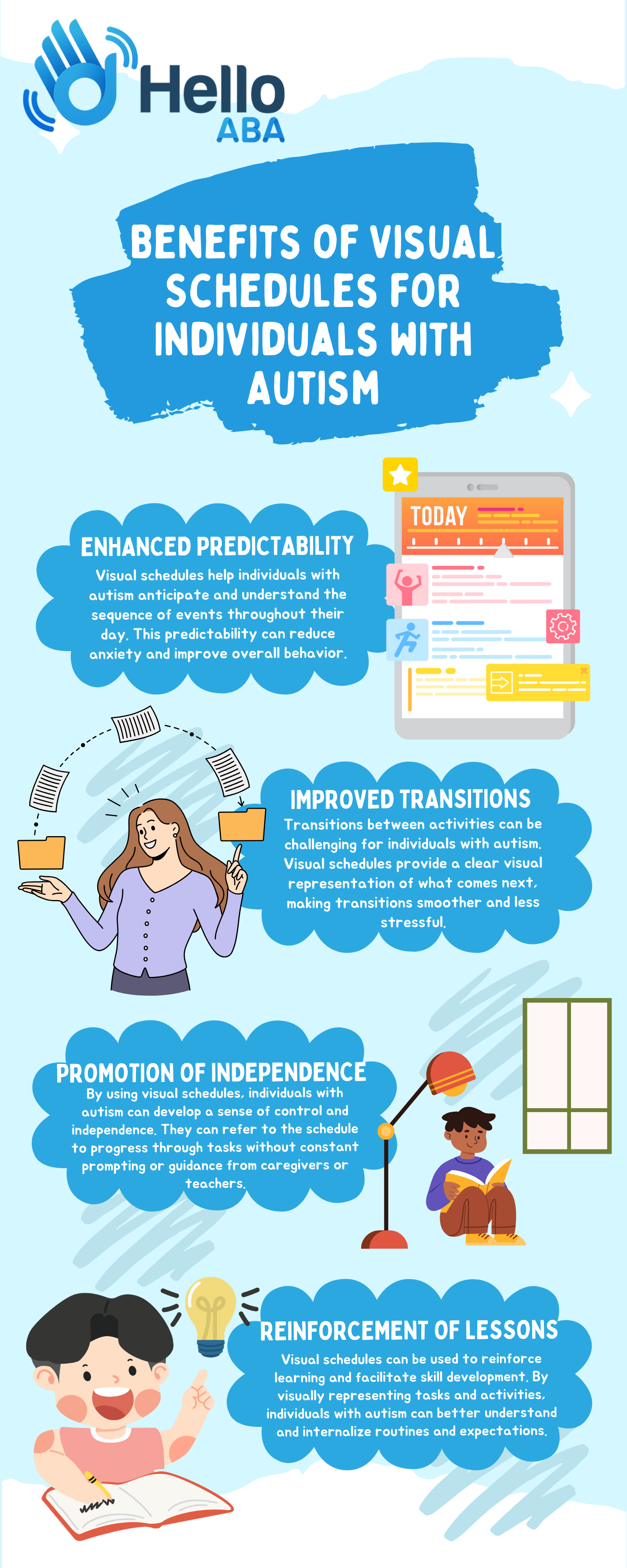Visual schedules and routine charts are essential tools for empowering parents and caregivers of individuals with autism. These visual aids provide a structured and predictable framework that helps individuals with autism navigate their daily routines with greater ease. Understanding the benefits of visual schedules and their importance for autistic learners is key to effectively implementing this valuable tool.
Benefits of Visual Schedules
Visual schedules offer a range of benefits for individuals with autism. These benefits include:

Importance for Autistic Learners
For autistic learners, visual schedules play a crucial role in promoting their overall development and well-being. Here are some reasons why visual schedules are particularly important for individuals with autism:
- Visual learning style: Many individuals with autism have a visual learning style, meaning they process and understand information better when presented visually. Visual schedules capitalize on this strength, making information more accessible and comprehensible.
- Reduced anxiety: The predictability and structure provided by visual schedules can significantly reduce scheduling-related anxiety in individuals with autism. Knowing what to expect and having a clear visual representation of their routine can create a sense of security and comfort.
- Promotion of independence and self-regulation: Visual schedules empower individuals with autism to take ownership of their daily routines and develop essential life skills. By visually representing tasks and expectations, individuals can follow the schedule independently and build self-regulation skills.
- Consistency and routine: Autistic individuals often thrive on consistency and routine. Visual schedules help establish and maintain these routines, which can be comforting and provide a sense of stability in their lives.
Understanding the benefits of visual schedules and their importance for autistic learners is a fundamental step in supporting individuals with autism. By incorporating visual schedules into their daily lives, parents, caregivers, and teachers can provide the structure and support needed for autistic individuals to navigate their world with confidence and independence.
Implementing Visual Schedules
Visual schedules are powerful tools that can greatly benefit individuals with autism. They provide a visual representation of a sequence of events for specific tasks or activities, helping autistic learners understand what they are expected to do. We’ll delve into the essential steps for implementing visual schedules, covering how to create an effective visual schedule and choose the appropriate visual style.
Creating a Visual Schedule
For an effective visual schedule, tailor it to the child’s needs with clear visuals and consistency. Involving the child in its creation can enhance its usefulness. Here are some steps to follow:
- Identify the target skill or routine: Determine the specific skill or routine that you want to address with the visual schedule. It could be morning routines, mealtime, or transitions between activities. Clearly define the steps involved in the routine to create a comprehensive schedule.
- Find the right visual style: Choose a visual style that suits the needs and preferences of the individual with autism. Some common visual styles include using photographs, picture symbols, or written words. Consider the individual’s communication abilities and visual preferences when selecting the style.
- Include a mix of activities: Incorporate a variety of activities in the visual schedule to provide a comprehensive view of the routine. Include both preferred and non-preferred activities to maintain engagement and promote flexibility.
- Keep the schedule accessible: Ensure that the visual schedule is easily accessible to the individual. Consider using a portable schedule that can be carried or displayed in multiple locations. Use a clear and organized format that is easy to understand.
- Involve the child in the process: Encourage the individual with autism to participate in creating their visual schedule. This involvement promotes a sense of ownership and increases motivation. Allow them to choose the visuals or participate in arranging the schedule.
- Involve other caregivers for consistency: Share the visual schedule with other caregivers, such as teachers or therapists, to maintain consistency across different environments. This helps the individual generalize their routine and provides continuity in their daily activities.
Selecting the Right Visual Style
Selecting the appropriate visual style for a visual schedule is crucial for its effectiveness. Consider the following factors when choosing the visual style:
- Communication abilities: Take into account the individual’s communication abilities. For individuals with limited verbal skills, picture symbols or photographs may be more suitable. If they have strong reading skills, incorporating written words may be beneficial.
- Visual preferences: Observe the individual’s visual preferences and use visuals that are visually appealing and engaging for them. Some individuals may respond better to realistic photographs, while others may prefer simplified picture symbols.
- Symbol clarity: Ensure that the visuals used in the schedule are clear and easily recognizable. Choose symbols or photographs that accurately represent the target activity or task. Avoid using complex or abstract images that may cause confusion.
Creating a visual schedule that effectively supports the understanding and execution of routines and tasks for individuals with autism involves following specific steps and considering each person’s unique needs and preferences. By tailoring the schedule to these individual requirements, you ensure it is both functional and supportive, fostering improved engagement and comprehension.
At Hello ABA, we specialize in providing personalized autism services in Maryland, including ABA therapy that is designed to meet the unique needs of each individual. Our expert team is dedicated to crafting strategies that enhance daily living skills and overall well-being.
Contact us today to learn more about how we can help make a positive difference in your routine management.






